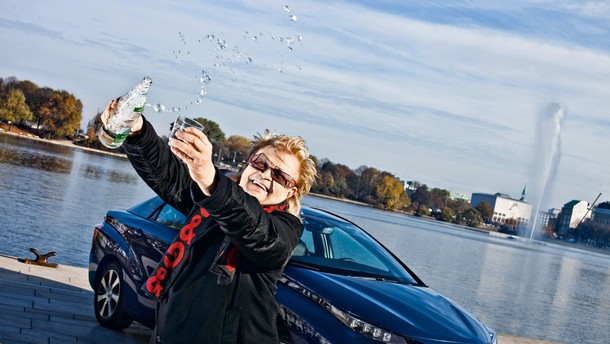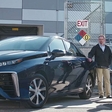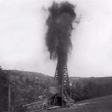
Naturally, the future is marked by hydrogen – and water. No more exhaust emissions, only water. HA Schult is an artist from Cologne, and his art is heavily influenced by it. We asked him to join us behind the wheel of a Mirai.
What is it about water and hydrogen? Hydrogen is the element that is used in fuel cells, and it is also a component of the water molecule. Water is the source of environmentally-friendly hydrogen, as well as the product that hydrogen changes into in fuel cells.
Water is also connected to HA Schult, a German action artist who dedicated most of his life to garbage. He has been using it as material for his works and installations since the beginning of his career in the 1960s, when he covered the streets of Munich in paper and waste. "Cities are becoming increasingly similar to one another, and so is their garbage," says Schult, as he explains why he is so attracted to it. In the future, there will be much more of it, but luckily, the attitude of people toward waste is changing. Not only towards waste, but towards the environment in general. Changes do not occur quickly and they are not evenly spread geographically, but they do happen.

For example, Toyota is a car manufacturer that, twenty years ago, made a pledge to offer cleaner and more environmentally-friendly cars to the market. Toyota started breaking new ground with hybrid cars. In the beginning, those were frowned upon. We wondered if they made any sense and judged them harshly. However, as the years rolled by, we got used to them. Customers warmed up to them, so the sales numbers now reach the millions. In the first seven years of production, there were about a million of hybrids on the roads, the next seven years saw another six million, today there are more than eight and, in the next two or three years, there will be over 10 million Toyota hybrid cars driving around.
HA Schult knows his hybrids. He covered a great number of kilometers in a Prius, as he took it from Paris to Almaty, Kazakhstan as a part of Action Blue project. He shares a similar experience with Rafael de Mestre (check his interview here), as the most difficult part of the journey for him was right at the end, in Kazakhstan. "The roads were terrible, there were no signposts. That part of the way was a real adventure," he says. "Mirai is much like Prius, in that it is easy to use. The first time I climbed into the seat of a Prius was at the beginning of my long trip, I pressed the start button and drove off. I like that, no complications, sit and drive. Mirai is like that," says HA Schult, nodding contentedly.

It is not so different with plug-in cars, only the growth was much faster in the beginning. Six-plus-digit sales numbers are a thing of the future, though, and the same is true for electric cars that conserve energy as hydrogen. However, Toyota does not seem troubled by the prospect, more likely it is the opposite, as Mirai is the Japanese word for "future." Toyota claims that Mirai is a herald of the class of long-distance electric cars. In their words, hydrogen-powered fuel cells will have a future in large private cars and commercial vehicles. Smaller vehicles would be equipped by plug-in-hybrid propulsion, and electric cars would be focused on local or urban use.
There is plenty of hydrogen on the planet, and the yearly production is large, about 50 million tons, but sadly, it is produced from non-renewable sources. Hydrogen produced by electrolysis, using electricity from renewable sources, accounts for a much smaller percentage. Nevertheless, that production is well ahead of demand that would arise from mass usage of cars using fuel cells. For example, Denmark has highly-developed electricity production using wind energy. It often happens that their production exceeds the needs. Hydrogen is an ideal solution for conserving extra energy in such cases. All Mirais that Toyota plans to sell in the EU, this year and the next (around 150 vehicles), could run almost exclusively on such extra energy.

Fuel cells are not a brand new solution. Toyota had their first officially-approved model (in serial production) using fuel cell propulsion technology driving around ten years ago. Naturally, the propulsion technology has made significant progress since then.
Toyota developed a brand new generation of fuel cells, now smaller and lighter, while at the same time they are more efficient. Their volume and mass was cut almost in half, while the power increased by more than a fifth, to 114 kW or 155 hp. That is what allows Mirai to power its synchronous electric motor, capable of 155 hp. With 335 Nm torque, it is enough to move the 1.9 ton car quickly enough, though with 9.6 seconds acceleration to 100 kilometers per hour, it cannot outrun some of the electric cars from other manufacturers. It is adequate for keeping up with city and suburban traffic. Mirai can reach up to 178 km/h on highways, while a 160 km/h cruising speed causes no trouble at all. With all that performance, Mirai remains a comfortable low-noise car, which is what HA Schult noticed immediately. He also noticed the car's mass. "It shows a bit while decelerating, and it's not as immediately lively as Prius. But when it's on its way, it's running well," he added. The car pleased hi enough that he contemplated taking the Action Blue project further using a Mirai. "The journey was only temporarily halted in Kazakhstan, as there were exhibitions to prepare. In addition, a catastrophic explosion occurred in the port town of Tianjin, and my Chinese colleagues advised me to hold on for a while, before tackling the final part of the path into the heart of the Gobi Desert," he explained. Gobi and water? "Yeah, one can find water there, and Mirai also produces some."

To be exact, Mirai produces around 8 liters of water per 100 kilometers, as a product of a chemical reaction between oxygen and hydrogen in the fuel cells. There are 370 fuel cells, with a total capacity of 650 Volts. Electrical energy is supplied directly to the engine, with any surplus stored in a battery with a capacity of 1.6 Kilowatt-hours. The battery stores energy and "fills the gaps," if the consumption is greater than the current capacity of the fuel cell. The Nickel-metal hydride battery is the same as in hybrid Camry, and the whole system, from the fuel cells onwards, is practically the same as with the Toyota hybrids, which made for lower development costs and the car price. The price demonstrates the fact that Mirai happens to be at the top of the current car eco-industry. Hydrogen is not cheap (yet): 1.2 kilograms of hydrogen per 100 kilometers (official numbers are lower – 0.75 kilograms) amounts to a cost of around 11 Euros, which translates to 10 liters of diesel per 100 kilometers. Hydrogen still happens to carry a higher price tag, even if the price keeps dropping. It was the same with exceptionally expensive electric car batteries, in the beginning.
Hydrogen tanks, which can store 5 kilograms of hydrogen in total, are also newly-developed. The amount allows for 600 kilometers in theory, or 450 to 500 actual kilometers of drive. The tanks are constructed of plastic, reinforced with carbon fiber. They weigh 86 kilograms and can withstand almost 1,500 bars of pressure (maximum fuelling pressure is 700 bars). They are located under and behind the rear seats, and are highly protected, in case of collision. Despite hydrogen tanks, the booth still boasts a volume of 376 liters, which is enough for several suitcases and HA Schult's metal bag, that has accompanied him around the world for three and a half decades. "I bought it on Canal Street in New York at the beginning of 1980s, and it's been with me ever since. In the desert, in the polar cold, everywhere," he says, and pulls out some photos he took during the Action Blue project.

"Each of the 37 days of my journey with the Prius saw me taking water samples. From rivers, lakes, and gutters. I kept a heavy microscope in the car that we hauled to our hotel rooms every day. There, I would insert water samples and take photos. This way, I made visual biological signatures of water taken throughout the trip, from the Seine in Paris to a ditch at a taxi stop in Almaty," he said while explaining the purpose of the journey. "The photos were meant for the exhibition, which was put on display in Luxemburg, and will travel around the world, to alert us about the importance of water." Needless to say, the moment he was able to, even before our story began, he pulled himself out of the Mirai to take a water sample underneath it.
If you think that this 76-year-old artist is quite attached to cars, you're correct. In the beginning, he cooperated with Citroen. Later he spent many years with Ford (the famous Gold Winged Car on the roof of the City Museum in Cologne is actually a Ford Fiesta). Cars have been a part of his many installations from Der Stau, Crying Cars, Car Cathedral to Action Blue. Nevertheless, HA Schult still likes garbage best. The most famous of his artworks is Trash People, a group of statues in human form, made out of garbage. There are around a thousand of them, and they travel the world in twenty shipping containers. They have gone places, from the Pyramids in Egypt to the Arctic, from the Great Wall of China to Zermatt. "That was the most demanding and expensive feat of the Trash People project," says HA Schult. "It took 80 flights with a helicopter to put up the exhibition, and later dismantle it. To avoid disturbing nature and tourists, we could work only 3 hours per day. It took two weeks to put everything up, and the total cost exceeded that of setting up the exhibition on the Great Wall," he adds, as he slaloms the city streets in his Mirai. Naturally, his artistic eye inspects the interior design of the car. The position of the large central touch screen bothers him a bit, but overall he seems to like Mirai's interior. He is great behind the wheel on the city streets, also because he used to work as a taxi driver when he was young. "I also used to drive cars to Iran," he adds. "Several times per year, I would buy them here, then drive them to Iran and sell them."

He is very familiar with Asia, especially the Chinese part, where he teaches as a professor at one of the universities. He knows about the traffic there. "There is a great number of electric cars," he says. "Cars with fuel cells will be very important to China, if they decide to invest in the infrastructure. The process is centralized there, therefore easier to do. Although, Mirai should be somewhat larger over there, as they prefer cars where one can ride at the back, therefore the cars have to have more room. But Lexus can take care of this part," he adds.
Mirai's interior design is not as extravagant as its exterior. We are sure that the latter will attract some who will adore it, and deter others who will just hate it. It is still interesting to learn that Mirai somehow grows on you, after you see it a few times in person. "I like it, it shows character, it lets you know that it's something different, and this is how it should be," said HA Schult. The interior is marked by a big frame of black plastic (the dashboard) and LCD screens. There is plenty of room, and low-noise technology with solid audio isolation make you feel comfortable. Every so often, you can hear the soft hum of the fuel cells, and the large mass of the car combined with a softer chassis takes care of softening the effects of road bumps. There are plenty of electronic security and comfort accessories. The back seat offers enough room, even for our two-meter-tall artist, who did not complain when we drove back to the airport. While we were saying our goodbyes, a pilot passed us by on the way to work. He took a long glance at Mirai. We have to admit that the car certainly attracts glances. In the same way as HA Schult's artworks do, over and over again.

How do fuel cells work?
In reality, fuel cells operate in a simple way. Each of 370 cells holds an electrolyte membrane, covered with a catalyst based on platinum and cobalt on both sides. Those act as electrodes. On each side of the membrane is a net of tubes, made of artificial materials. Hydrogen from the tanks is accessed on one side of the membranes, and the air comes from the other. Oxygen from the air reacts with hydrogen, which results in electric energy (the opposite of electrolysis) and water. According to official figures, Mirai uses 0.76 kilograms of hydrogen per 100 kilometers, and breathes 20 cubic meters of air, which is where it gets its oxygen. The final product is 8.1 liters of water.
The numbers
If we play a bit with consumption and exhaust data, we get to some interesting numbers. The current yearly production of hydrogen is around 50 million tons, the larger part from non-renewable sources. Renewable sources (electrolysis with electricity from renewable sources) provide approximately 4%, which amounts to around two-hundred-thousand tons per year. That would suffice for the yearly consumption of 10 million Mirais which could cover 20,000 kilometers per year. 40 billion cubic meters of air would be needed (that amount of air would fill a cube with 3.5 kilometers per side), and all of them would release around 16 billion liters of water, enough to fill up almost 7000 Olympic swimming pools...

About HA Schult...
76-years old HA Schult is a German installation, happening and conceptual artist known primarily for his work with garbage. He started his career in 60s in Munich, not only as an artist but also as a taxi driver, art director for a bank and other various jobs which supported his art. He also lived and worked in New York, and is now based in Cologne. His most famous trash works include "Situation Schackstrasse" (covering street in Munich with trash), "Der Müll des Franz Beckenbauer" (displaying famous footbalers' trash), "Crash" (crashing a plane into New York's Staten Island dump), "Golden Winged Car," "Beach Hotel," "Trash People" and "Action Blue."





